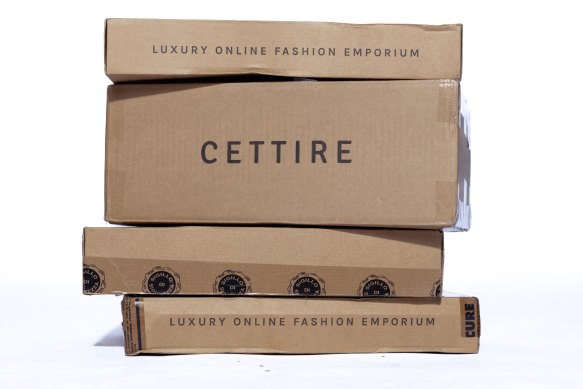This Australian billion-dollar luxury fashion retailer has taken the world by storm. But read the fine print
By Colin Kruger
For Aussie investors on the lookout for local companies taking the world by storm, luxury fashion retailer Cettire is hard to miss with its shares up more than 900 per cent since July 2022. And it is not hard to see why.
This week, a frill detail sleeveless top from Alexander McQueen was advertised on the fashion group’s website for $845. That same top was available from Cettire for $550.79.

The latest fashion from Alexander McQueen, seen here at Paris Fashion Week, is available at Cettire with a significant discount. Credit: Getty
That’s just one example of Cettire’s pitch to the market, its ability to offer the latest fashions at a significant discount on the official retail channels of the luxury brands.
As its reclusive founder and chief executive Dean Mintz explained to analysts and investors at Cettire’s December half-year results – where it reported a 90 per cent jump in sales to $354.3 million and a net profit of $12.8 million – the retailer is just getting started.
“The luxury market is enormous and in the early stages of moving online; we are well positioned to continue to benefit from the secular growth as online continues to grow its share of the market. This provides us with a real tailwind,” Mintz says. And investors couldn’t be happier.
“The growth in the company’s net revenue has been astonishing,” fund manager LHC Capital said in a recent update to its investors.
“In the last three years alone, Cettire’s revenue from ordinary operations has increased more than 17-fold. Moreover, Cettire is profitable, is able to self-fund its extraordinary growth and sustainably generates positive free cash flow.
“We believe this business could grow to be multiples larger than its current size over time,” LHC said.
But Cettire has also become the most polarising success story on the market, with the group seemingly reluctant to lift the cloak and dagger mystery around how it actually makes money.
Part of the problem appears to be that Cettire cannot be too boastful of its success due to the nature of its operation. The company is what is known in the online retail industry as a dropship retailer.
In a nutshell, Cettire does not own the Jimmy Choo heels or the Prada Re-Edition 2005 shoulder bags it is selling on its website, and it has no relationship with the luxury brands that make the goods. It doesn’t hold nor does it ship any of the goods it sells on its website.
The clothes and accessories are owned by European distributors and retailers who need to offload excess stock but also need to remain anonymous as their supplier relationship with these brands relies on them keeping quiet about these backdoor sales via the so-called grey market.
These are not opaque risks. Cettire investors were given clear warning in the prospectus, ahead of its public float in December 2020, of just how tenuous its supply of luxury goods is.

Cettire founder Dean Mintz has sold more than $300 million worth of shares since its ASX listing in December 2020.Credit: AFR
More software than retail?
For Cettire, it all starts with suppliers. And then extends to the luxury brands themselves.
“Many of Cettire’s agreements are relatively short term and/or terminable at will,” the company points out in its prospectus.
“It is possible that the manufacturers may change their arrangements with Cettire’s suppliers so as to limit the suppliers’ ability to sell to Cettire or to Cettire’s customers, either generally or in specific geographic locations.”
Meanwhile, Cettire’s decision to go public may have added another degree of danger to the business’ supply pipeline.
“The risk of manufacturers taking this kind of action may be increased by the company listing on ASX and the scale of its operations becoming more visible as a result of financial reporting and continuous disclosure obligations,” the prospectus says.
In response to queries about these issues, Cettire emphasised the current strength of its supply channels.
“Cettire’s available inventory has more than tripled since IPO and, with more than $2 billion in accessible inventory, the company is bringing to market one of the largest selections of luxury in the world. The company does not take this for granted and works hard to maintain and expand its industry relationships,” a company spokesman said.
For all of these risks, when the business model clicks, the economics are brilliant for Cettire.
The company receives money from shoppers before it has even bought the designer goods from its web of suppliers, which means it always has cash in the bank. It holds no inventory and only needs to ensure the logistics of moving the goods from supplier to customer, taking care of any taxes and duties and customer support.
The risks and rewards are well understood in this context. But then we get to the big selling point: its ability to offer the latest luxury goods at a steep discount.
This goes to the heart of the controversy surrounding Cettire, whose valuation catapulted to a record $1.8 billion in February based on its soaring sales and earnings.
According to Cettire, its secret sauce lies with its back-end technology systems that connect it seamlessly with its web of suppliers and their $2 billion worth of inventory.
“We currently operate with approximately 70 FTE [full-time equivalent staff], a significant proportion of which relates to technology and software engineering talent,” it says.
No wonder LHC Capital has described Cettire as a business more akin to a software company, based on its technology. “The software is integrated into its suppliers’ technology stack, giving Cettire live access to inventory which is then largely automatically curated and published on its website.”

Cettire has enticed shoppers by offering the latest high-end fashion at low prices, but controversy has grown over how it actually does this. Credit: Dominic Lorrimer
While this does not fully explain the significant discounts the business can offer, industry veterans say Cettire’s position in the grey market of fashion retail gives it the edge on prices.
Selling online – and mostly outside the European Union – means Cettire can exploit loopholes in trade regulations that would otherwise see it pay value-added tax (VAT) in the EU, or duty on goods delivered to the US, which is its largest source of business.
Tommy Mathew, a fashion e-commerce veteran with brands such as Acne Studios and Helmut Lang who now works as an independent consultant to fashion brands, did his own report on Cettire in 2021 when it was starting to make waves.
“The main reason they have been able to grow is that most of their customers are outside the European Union, so they can sell European designer fashion without the 20 per cent VAT, effectively offering a 20 to 30 per cent discount on new luxury goods to customers willing to buy cross-border,” he says.
Mathew told this publication that other vendors could do what Cettire does but the ASX-listed group does have an edge.
“Some other sellers could do what Cettire does and, functionally, many of their own suppliers [boutiques in Italy] that sell online and cross-border to the US will do what Cettire does, too, but they don’t have the same digital marketing budget that Cettire has,” he says.
Customs controversy
The retailer has also been recently subject to more serious allegations. The Australian Financial Review reported on purchases its reporters made with Cettire where the group charged customers duty on the goods purchased but which, according to shipping records, did not appear to pay it to the proper authorities.
The AFR story sent the share price plunging more than 20 per cent and the stock has yet to fully recover as traders and journalists dig further into discrepancies between the taxes and duties being paid by customers and Cettire.
The investor reaction was understandable, given that any aspersions cast on Cettire’s incredible profit engine, compared with its failed rivals like Farfetch, would pose an existential-level threat to the business.
In its response to the allegations, Cettire said, “All applicable duties and other import charges are paid to the relevant authorities at the point of customs clearance.”
“Cettire is registered for sales tax and remits sales tax in the states where it believes it has registration obligations,” the company added. This masthead does not suggest that Mintz is aware of any duties irregularities.
However, the allegations made in the AFR story are not being discounted by Ron Shamgar, head of Australian Equity Strategies at TAMIM Asset Management, which was an early investor in Cettire but no longer has a financial interest in the stock.
“To be honest, they were always very secretive … It was very opaque,” he said of his dealings with Cettire while an investor.
“Sometimes, with a company, something doesn’t feel right – or it’s almost like, too good to be true – and that was the case with Cettire,” he says.
Shamgar says he has never heard of any business being able to generate the massive sales of Cettire – approaching $700 million this year – with so few staff.
“It’s unheard of,” he says.
The fact that company founder Mintz has extracted $310 million from the business in share sales in barely two years is a point that Shamgar finds amusing, as well as the fact that many investors are willing to buy shares at such an extraordinary price, despite what he sees as warning signs.
“There are red flags here and maybe the model is not sustainable,” he warns.
Mathew also sees risks coming from another direction as the big luxury brands get serious about going direct to their customers.
“Brands are more interested in selling online through their own channels, and when they see the competition coming from Cettire – in terms of price on the first page of Google results – they’ll have to do something about it eventually,” he says.
“The only way brands can really stop this is by cutting off multi-brand boutiques that supply Cettire. As traceability in supply chains improves through radio frequency identification (RFID) or other means, it may become easier to identify who’s supplying Cettire and then cut them out.”
The Business Briefing newsletter delivers major stories, exclusive coverage and expert opinion. Sign up to get it every weekday morning.